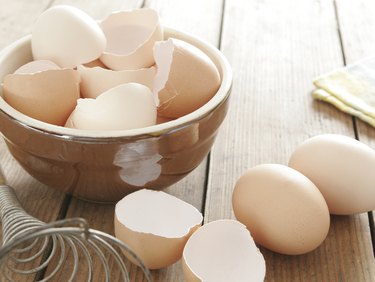
Calcium in soil plays a role in plant cell membranes and walls, as well as the cell division process. It moves through plants with the water they absorb through their roots. Blossom-end rot in certain crops -- often tomatoes (Solanum lycopersicum), bell peppers (Capsicum annuum) and eggplant (Solanum melongena) -- is sometimes caused by a calcium deficiency in the soil. Adding calcium to the soil helps prevent the problem.
Calcium Sources
Video of the Day
Lime is a common soil amendment that adds calcium to the garden. Lime also helps correct soil pH and can be added when a soil test indicates the pH is lower than the ideal range for most vegetables; that optimal range is 6.2 to 6.8. The addition of lime makes acidic soil closer to the neutral pH range. If a soil test indicates that your garden soil's pH is already in the ideal range, then gypsum can be used as an alternative source of calcium. Also, eggshells are a natural way to support soil's calcium levels. Adding compost that has eggshells or burying eggshells directly in your garden boosts the soil's calcium level.
Video of the Day
Application Timing
Soil amendments need time to react with the soil. Your calcium supplementation works best when you can apply it before you plant. Calcium can't be worked easily into an established garden's soil without damaging plant roots. Applying calcium early gives the nutrient the time needed to react and benefit plants. Regular ground limestone can take several weeks to work fully. Fast-acting lime is available to cut down on the reaction time.
Application Method
Soil amendments are most effective when they are worked into the soil. The ground should be loose before applying lime so it is easier to work into the soil. A soil test's results can help you determine the amount of lime or gypsum required if you also want to correct the soil's pH level. Mix the required amount of lime or gypsum into the top 12 inches of soil. Using a garden tiller is a simple way to work either of those calcium sources into soil. The tiller will mix the calcium into the soil for you.
Calcium Availability Support
You can improve the availability of calcium in soil and reduce the risk of blossom-end rot with a few simple techniques. Excessive amounts of potassium, nitrogen and magnesium from fertilizer can inhibit a plant's ability to use the calcium in soil. Excessive shoot growth is one indicator that a plant received too much fertilizer, and it may be an early sign of blossom-end rot. If you notice blossom-end rot on your plants, then apply -- two or three times per week -- a premixed calcium spray designed for plants. Using the spray can support other measures designed to add calcium to the soil to correct problems caused by calcium deficiency.
- University of Georgia Extension: Blossom-End Rot and Calcium Nutrition of Pepper and Tomato
- Bonnie Plants: Conquer Blossom-End Rot
- University of Florida IFAS Extension: Soil pH and the Home Landscape or Garden
- University of Wisconsin Extension: Understanding Plant Nutrients -- Soil and Applied Calcium